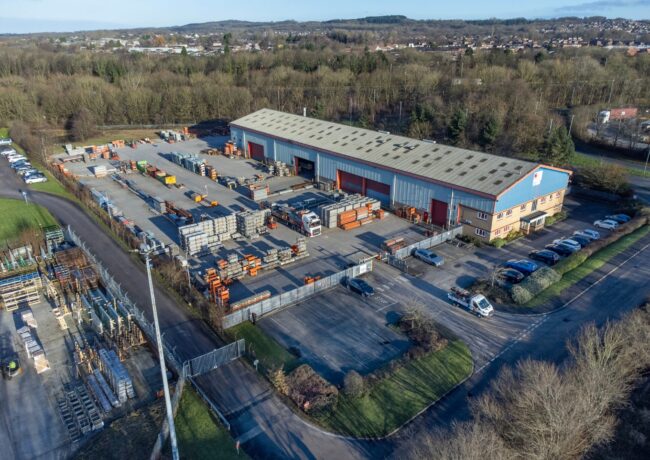IN FOCUS | Logistics shows signs of cooling as funding tightens
The previously red-hot sector is experiencing a softening in prices and demand as developers, funders, and occupiers “pause and wait” for greater market stability.
Industrial land values in the North West have dropped by around 30% since the start of the year – more in some secondary locations – according to John Sullivan, director of Colliers’ Manchester industrial and logistics team, while funding for new build developments is increasingly hard to come by.
To give an example, the development loan offer for a plot in a prime location of Warrington in recent weeks amounted to a price per square foot £20 cheaper than the offer from another lender for a similar plot just one month earlier, another industrial agent told Place North West.
On the demand side, occupier take-up of logistics property nationally has dropped “considerably” in the third quarter of this year – by 28% compared to the previous quarter, to 11.6m sq ft from 16.2m sq ft, according to the latest market update from consultancy Cushman & Wakefield.
The research, published today, nonetheless claims that UK logistics property remains healthy despite macroeconomic challenges, as take-up is still 40% higher than the pre-pandemic Q3 average. Moreover, a total of 43.9m sq ft of space has been leased over the first nine months of 2022, which exceeds the five-year average.
“Activity has been buoyed primarily by demand from third-party logistic providers, well-positioned retailers, and the manufacturing sector, together accounting for 67% of the space occupied in 2022 so far,” Cushman & Wakefield said. The study provided no regional breakdown.
Price reset
Industrial agents in the North West told Place North West the market was definitely experiencing a cooling off compared to the recent years of almost frenetic development and leasing activity, where take-up and prices reached record highs.

Colliers’ John Sullivan. Credit: Place North West
“The current economic instability has not yet hugely affected the occupier market, but there is no doubt that the cost of living squeeze will have an impact,” said Sullivan.
“The investment market has slowed and spec funding has almost ground to a halt and is certainly seeing a price reset. While there are still occupiers looking for space, land values have dropped, so for developers when you chuck in high construction costs it often doesn’t make sense to build.”
Industrial yields for 100,000 sq ft units are estimated at 5.5%-6% right now – still healthier than other sectors of commercial property such as retail, where they often stand at around 7% – but they were 3.75% not long ago, Sullivan added.
“Many of the region’s industrial developers have built up a land bank so they are not panicking, but others are saying the numbers aren’t going to work as they would make a loss, or they are going out to market with design and build contracts to target occupiers in the market that way. I can count on one hand the [number of schemes] coming forward.”
Sullivan predicted some occupier insolvencies in the months ahead, which would shrink the market, while other companies may only search for new space if they have lease expiries or renewals coming up. “Many are just holding back, pausing and waiting, and seeing where the economy is going because if they do move, they won’t get the same deal.”
In recent years, a shortage of quality industrial space in the North West to meet rocketing demand driven by the rise in e-commerce, among other factors, has kept rental prices high.
“We are still saying it’s a landlords’ market,” said Sullivan. “But occupiers, if their margins are being seriously squeezed, are pushing for compromise. It’s a bit of a conundrum for landlords and occupiers.”
Colliers is still predicting industrial rents across all types of units in the region will rise this year, but at a slower rate of around 4.9% compared to 9.9% in 2021, Sullivan added. “There is flux and uncertainty in the market, and we are constantly having these conversations and giving reassurances,” he said.
Pipelines down
Joe Burnett, development director at Network Space, which is building warehouses across Greater Manchester and Merseyside, agreed the market is experiencing some challenges.

Joe Burnett. Credit: via Network Space
“A lot has changed over the course of a year,” he told Place North West. “From a developer’s perspective, inflation and cost pressures have been building for some time. However, until recently, this has been offset by continued improvement in values, which has been a consequence of good depth in the occupier market and an undersupply of space, coupled with a strong appetite from investors looking to acquire industrial property.
“However, we are now seeing a softening in the investment market, with investors suffering from interest rate rises and increased finance costs, which impact yields and the price they are able to pay for a property to achieve the necessary level of returns.
“We saw some early signs of the market shifting at the beginning of this year and the trend seems to have continued through the summer months and to today.”
While the occupier market has remained strong to date, with rising demand and rents, “it seems inevitable that it will follow the investment market and begin to slow”, Burnett added, saying that he had heard of several large occupiers reporting reduced volume forecasts over the course of the next year.
“If you add all of these factors together, the viability of industrial development is really under threat, and I anticipate a significant reduction in the number of projects coming forward in the short term at the very least.”
Peel Ports warned this month of upcoming redundancies at the Port of Liverpool, as the operator restructures its containers division following a “marked deterioration” in the volume of containers the port is handling. This is largely due to the “bleak outlook on the global economy, with rising interest rates, higher energy costs, and weakening consumer demand for manufactured and imported goods”, the company said.
But prognosis still ‘strong’
Steve Widdowson, director at construction firm Caddick, said you could speculate about the impacts of the global economic outlook on almost every sector of commercial property, but because industrial has been so hot, any change is likely to be felt acutely. “Land and rental prices got very toppy, so there does need to be a bit of an adjustment.” Financing for large schemes has “all but stopped for now”, he added.

Caddick’s Steve Widdowson. Credit: via Caddick
“However, generally our view is that the market is starved of stock and the temporary switch-off of funding for new developments will only exacerbate the situation. So we think the demand for space and the resulting prices will remain high and the prognosis for the sector is reasonably strong.”
Burnett also highlighted the sector’s underlying fundamentals. “On a more positive note, there is an undersupply of good-quality space on the market; the shift in consumer retail habits from the high street to online continues, which will maintain the demand for warehousing, storage, and delivery; tenants seem to be meeting rental commitments and we are not seeing too many defaults, and, finally, investors do still appear to be committed to acquiring industrial space in the future.”
Cushman & Wakefield concluded the same in its report, hinting at a temporary pause in market activity rather than a sustained slowdown.
The consultancy’s head of UK logistics Richard Evans said: “Despite the current economic outlook, occupier demand remains robust, and while undoubtedly the market will slow, it remains well placed to weather the macroeconomic storm. Following unparalleled post-pandemic growth, some compression is inevitable and probably necessary.”




